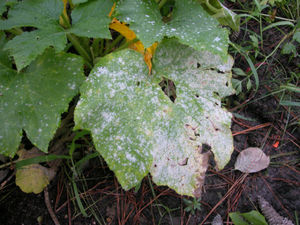Southern summers are stressful for humans, animals, and plants. A favorite southern saying is “It’s not the heat, it’s the humidity,” which is something I can tell you from experience is very true. The one thing that thrives in a hot, humid southern summer is fungus, and the most common vegetable garden fungus is powdery mildew. While we humans can sit on the front porch with a fan and a glass of iced tea to cool off, your vegetables need a little special attention to survive and thrive. But don’t pull out those nasty chemicals yet! There are natural alternatives to control powdery mildew in the garden.
Powdery mildew is caused by several species of mildew fungi, each attacking specific plants. The spores overwinter in plant debris, so making sure you clean up the garden in the fall is a good step toward prevention.
How to Prevent Powdery Mildew
Powdery mildew is spread by insects, splashing water, and wind. The best preventative measures for powdery mildew in your southern vegetable garden are:
- Plant resistant vegetable varieties. Hybrids are your best bet for disease control in southern gardens. Check seed or starter plant labels for fungus resistance.
- Don’t plant too closely. Follow the spacing directions on the package or tag to ensure that your plants get enough air circulations between and around them. Fungus thrives in stagnant air.
- Don’t water from overhead. Drip irrigation is best, but if that isn’t possible, make sure to water your vegetables early in the day so the sun can dry the leaves thoroughly. Overhead watering also splashes soil fungus onto the plants.
- Don’t water at night. Leaves need to be kept as dry as possible. Night-watering allows the powdery mildew fungus to take a foothold on wet plant parts overnight.
- Make sure vegetables are planted in full sun. Plant fungi thrive in the shade, where it is cool and moist.
- Make sure plants have good air circulation. Air movement keeps plant surfaces drier and keeps fungus spores from settling on the leaves.
How to Recognize Powdery Mildew
Powdery mildew begins as a white or grey splotches on leaves and stems. It affects all leaf surfaces, buds, flowers, stems, and even fruit. It’s usually noticed on the tops of leaves first. Heavily infected leaves yellow, then become dry and brown, and finally fall off. Although humid conditions can increase the severity of the disease, the fungus can reproduce under relatively dry conditions as well.
How to Control Powdery Mildew Naturally
Before spraying, remove and destroy all infected parts. Don’t fertilize infected plants, because powdery mildew fungus likes new, succulent growth.
Fungi can’t live in alkaline environments, so spraying your plants with 1 tbsp. of baking soda and one tsp. of non-grease-cutting dish washing liquid to a gallon of water during the most humid weather may stave off an infection. Make sure to spray early in the day, so that plants have time to dry.
For mild to moderate infestations of powdery mildew, neem oil or horticultural summer oil are effective treatments. Some southern gardeners claim success spraying with skim milk. More serious infestations can be treated effectively with liquid copper. Be sure to spray all parts of the plant. Treatments should be repeated every 7-10 days until the disease is controlled. When spraying oils, the cooler, early morning hours are best. To avoid leaf burn, never spray during the heat of the day.
Powdery mildew is unsightly, but rarely fatal, although repeated infections will weaken the plants, and may cause stunted growth and fewer fruits.
Keep your southern vegetable garden healthy by following these tips to keep powdery mildew in its place, and not on your vegetable plants.
Sources:
University of California: Powdery Mildew on Vegetables
University of Florida Extension Service: Powdery Mildew of Vegetables





